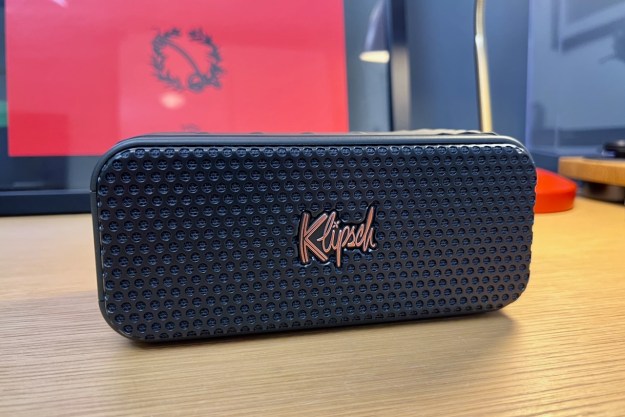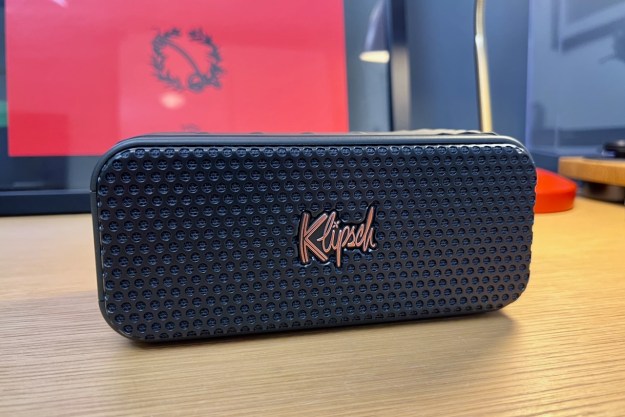
“Like its namesake, the Klipsch Nashville is all about the music. It’s rugged, compact, and with a little tweaking, sounds great for your summer travels.”
- Solid, rugged construction
- Sounds great at normal volumes
- IP67 dust and water resistance
- 24-hour battery life
- Needs EQ help to shine
- The app is pretty bare bones
- Basic physical controls
Klipsch Nashville review: a rugged, backpack-ready Bluetooth speaker
Just in time for the warmer months, the Klipsch Nashville is a $149 Bluetooth speaker aimed squarely toward on-the-go types looking to throw a rugged little speaker into a backpack or tote bag. For its compact size, the Nashville delivers a balanced and clear mono sound that, while lacking a bit in the bass department, can be coaxed into a sweet spot with a little EQing, and can be linked with other Klipsch Bluetooth speakers for more volume, too.
Its IP67 dust and waterproof rating means that the Nashville can take a roll in the sand or campsite dirt just as well as it can handle a dunk in the lake (up to a meter deep for up to 30 minutes) or a rained-out picnic. The accompanying Klipsch app is basic and works well, and the same can be said about the speaker’s physical controls, but it would have been nice to see a little more thought put into both.
After spending some time at home and on the road with the Klipsch Nashville, here are my thoughts.

Klipsch Nashville: design
Klipsch is a speaker brand that garners a ton of respect, as the company has been making some of the best audio products for decades. As part of its new Music City portable speaker series, the Nashville sits in the middle of the range that includes the smaller Klipsch Austin ($99) and the largest Klipsch Detroit speaker ($299).
The Nashville is built like a little tank, with no external parts like a handle or strap to get caught on anything in your bag. (Although a strap might have been nice for hanging it on things if you so desire.) The Nashville’s 3.1- by 7- by 3.2-inch (HxWxD) (and 2.4-pound) body is wrapped in a band of thick, grippy rubber that keeps it stuck firmly on most surfaces.
- 1. The basic controls of Klipsch Nashville
- 2. The box contents of the Klipsch Nashville
On top are basic power, Bluetooth, and volume buttons embedded in the rubber coating. You’ll also find a battery indicator LED, a Bluetooth connectivity LED, and a small microphone hole for phone calls. Buttons for play/pause or skipping tracks would have been nice, but you’ll have to resort to your phone for that. To access the Nashville’s USB-C port for charging, there’s a tightly sealed rubber panel cover on the side.
Behind the 20-watt Nashville’s metal front and back grilles, you’ll find two 2.25-inch drivers (one front-firing, the other rear-firing) and two passive radiators (again, firing front and back) with a frequency range of 60Hz to 20kHz. While the Nashville doesn’t produce stereo sound from its speakers, Klipsch bills the sound signature as its “360-degree Experience.” There are other comparable speakers, such as the $170 Marshall Emberton II, that separate the stereo channels between the front and back speakers, but at this size, most wouldn’t notice the sound separation in a form this compact.
Klipsch Nashville: features
The Nashville is a Bluetooth 5.3 speaker that, sadly, only supports the SBC codec. While not as rugged, the Sonos Roam comes with AAC support and Wi-Fi connectivity for $179. The good news is that the Nashville’s battery life destroys the Roam’s 10 hours, topping out at up to 24 hours, according to Klipsch, and it takes just an hour and a half to recharge fully. Plus, you can use the Nashville as a power bank to charge other devices like smartphones, and it comes with a USB-C to USB-C cable.
- 1. The rugged USB-C port cover
- 2. USB-C port
Consistent with several other Bluetooth speakers from competitors like JBL and Soundcore, Klipsch’s “Broadcast Mode”-capable speakers can be paired together (up to 10) on the device by simultaneously holding down the Bluetooth and up-volume buttons.
While this will surely bring a bigger, louder, and more immersive sound to your campsite, it still doesn’t do left-right stereo separation. For that, you’ll need to pair two Nashville speakers together, but it’s nice to know that it’s possible as the Nashville is relatively cheap, and two is always better than one.
Klipsch Nashville: Connect app
The Klipsch Connect app for iOS and Android is a nice accompaniment to the Nashville speaker, even if a bit basic. With it, you can control basic playback in tandem with whatever music app you’re using (volume, play/pause, and previous/next track), as well as facilitate firmware updates and factory resets.
By far, the most useful feature of the Connect app is its equalizer (more on this below) that offers five presets (vocal, bass, treble, and rock) and custom for when you opt to set the bass, mid, and treble sliders yourself. It’s a nice feature to have. But as I’ll get into below, the Nashville’s sound needs a little more TLC (and not the group) than the app’s basic three-band EQ provides, and I ended up using the Spotify app’s more robust EQ instead.
Lastly, the Klipsch Connect app is also handy for letting you turn off your device’s function sounds. This is great for silencing notifications so they don’t ping off in the middle of your pool party.
Klipsch Nashville: sound and performance
As a public service, let me just take the bass-heads aside and let them off the hook right now. If rich, thumping low end is your priority, you’re woofing up the wrong tree with the Nashville.
I started my testing of the Klipsch Nashville speaker with its EQ set to flat on the Klipsch app and on any apps that have EQ, such as Spotify. At reasonable volumes (at around 6 or 7 of its total of 16), the Nashville sounds quite good.

There’s good separation between the instruments and vocals (which is cool for a mono speaker), and in my small home office, I heard a surprising sense of height when listening to live tracks such as Elton John’s Benny and the Jets. Bass is decent at this volume range, as are the mids for vocals and instruments like piano and horns, and the trebles, while a little too shimmery for my liking, are well-balanced among the other ranges.
If you take a few minutes to add some EQ to the mix, though, either through the Klipsch Connect app’s three-band equalizer or, like I did, through Spotify where you get even more control, then you can improve the sound of the Nashville considerably. A few tweaks added that extra much-needed low end tempered those shimmery highs, and brought more depth to the overall sound.

I cycled through a variety of tracks and genres, from quieter fare like Belle and Sebastian and Beyonce’s excellent cover of The Beatles’ Blackbird, to progressively bolder stuff such as Olivia Rodrigo’s ’90s-tinged pop-rock, Travis Scott’s auto-tune extravaganza, and even Nirvana’s screamer, Territorial Pissings. Overall, I can say that the Nashville is a solid-sounding Bluetooth speaker.
However, don’t expect much from the Nashville if you’re into those sub-bass frequencies. Even riding the low end of the EQ slider didn’t do much on tracks like Massive Attack’s Angel, Rhythm & Sound’s Mango Drive, and Billy Eilish’s beautifully saturated Xanny, where it just sounded a bit farty.

Tighter bass tones on such tracks as New Order’s Blue Monday do indeed stay taut and controlled, even filling out nicely when the bass guitar kicks in, which shows that the Nashville’s bass can excel for certain types of music.
Things get even more challenging when you turn up the volume, though. Everything, not just the bass, starts to break up and get harsh in the highs as you reach the 11 and 12 range (around 70%), especially when listening to more aggressive guitar stuff like Nirvana. To be fair, if you’re looking for a loud Bluetooth speaker, then you should spend a little extra on something like the Nashville’s bigger sibling, the Detroit, or the fantastic Marshall Middleton ($237).
Klipsch Nashville: bottom line
The Klipsch Nashville is a little tank of a Bluetooth speaker that sounds great at normal volumes, will take a beating in the sand or surf throughout your summer, and won’t hit you too hard in the wallet.
With Klipsch’s famous lineage, you know it’s going to go the distance, and even if it does take a little bit of tweaking of the EQ to boost the low end and get it to sound just to your liking, one could argue that you might have to do that anyway with other Bluetooth speakers if your preferences are more specific — and many do not even give you the option.
However, the bare-bones app, basic physical buttons, and bare-minimum codec support make other options such as the Marshall Emberton II, Sonos Roam, and even the much smaller and cheaper Soundcore Motion 300 ($80) a little more attractive.
Editors’ Recommendations
Services Marketplace – Listings, Bookings & Reviews




